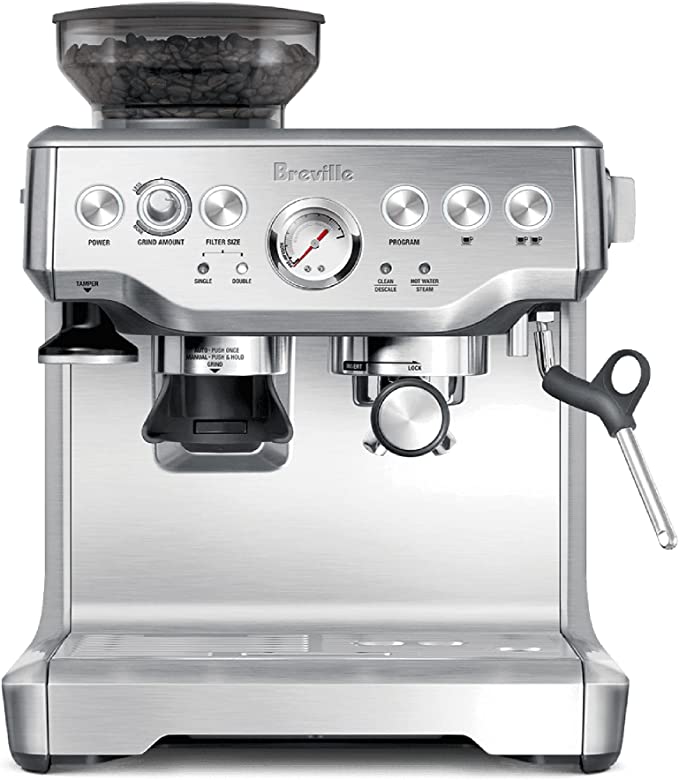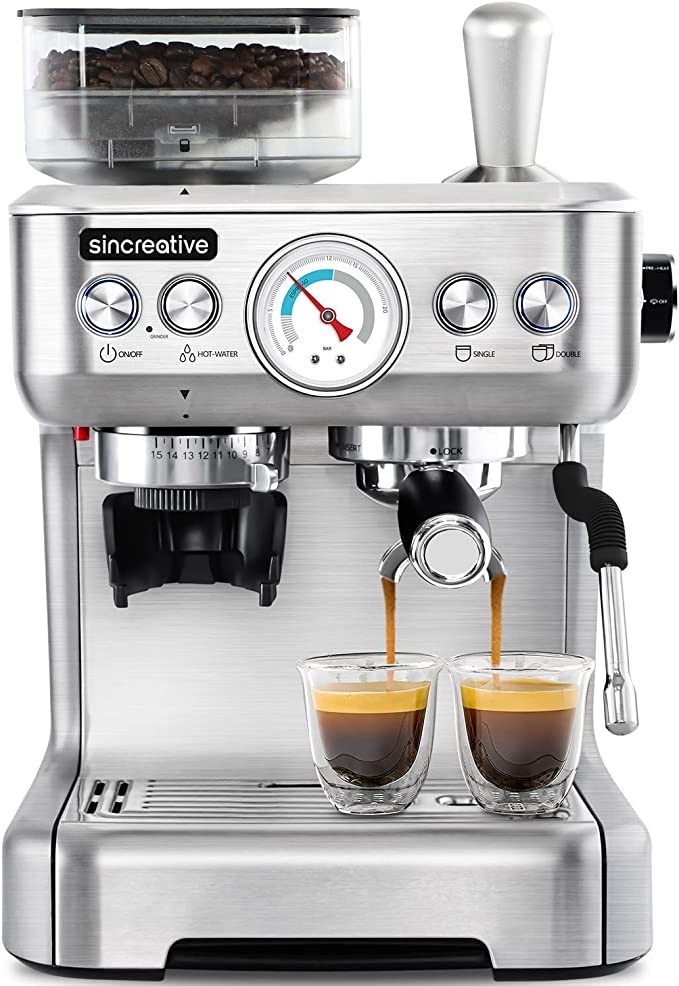De'Longhi ECP3630: Unlock Barista-Quality Espresso at Home
Update on Feb. 21, 2025, 10:14 a.m.
Mastering Home Espresso: The Science Behind the De’Longhi ECP3630
The aroma alone is enough to awaken the senses – that rich, complex scent of freshly brewed espresso. It’s a sensory experience that goes far beyond a simple caffeine kick. But achieving that perfect shot at home, the one with the velvety crema and the balanced flavor, can feel like an elusive art. Many aspiring home baristas find themselves intimidated by complex machines and inconsistent results. The truth is, great espresso relies on a few key scientific principles, and understanding these principles can unlock the potential of even a relatively simple machine like the De’Longhi ECP3630 Bar Pump Espresso and Cappuccino Machine.

Espresso Defined: More Than Just Strong Coffee
What sets espresso apart from other brewing methods? It’s not just about the strength or the fine grind; it’s about pressure. Espresso is created by forcing hot water, under high pressure, through finely-ground coffee beans. This process extracts a concentrated brew rich in oils, aromatic compounds, and dissolved solids, resulting in a unique flavor profile and that signature layer of crema – the reddish-brown foam that sits atop a well-pulled shot.
The Pressure Principle: Nine Bars of Excellence
The accepted standard for optimal espresso extraction is around 9 bars of pressure. This isn’t an arbitrary number; it’s the sweet spot where the water can effectively extract the desirable compounds from the coffee without over-extracting bitter elements. Think of it like squeezing a sponge – too little pressure, and you won’t get much out; too much pressure, and you might damage the sponge (or, in this case, over-extract the coffee).
The pressure in coffee extraction using the ECP3630 follows principles of fluid dynamics. Water at high speed passes between the coffee bean,extracting flavor.
The De’Longhi ECP3630 features a 15-bar pump. Why 15 if 9 is ideal? This extra capacity ensures that the machine can consistently deliver 9 bars at the coffee puck, even accounting for variations in grind size, tamping pressure, and the natural resistance of the coffee itself. It’s like having a powerful engine in your car – you might not always need all that horsepower, but it’s there to ensure consistent performance, even uphill.
Temperature’s Tale: The Importance of Stability
Just as crucial as pressure is temperature. The ideal brewing temperature for espresso falls between 195-205°F (90-96°C). Within this range, the desirable flavor compounds – the sugars, acids, and lipids that contribute to sweetness, brightness, and body – are efficiently extracted.
Go too low, and you’ll end up with under-extracted espresso, which tastes sour and weak. This is because the water isn’t hot enough to dissolve and extract those flavorful compounds properly. Go too high, and you’ll over-extract, resulting in a bitter, burnt-tasting shot. The higher temperature degrades some of the delicate aromatic compounds and extracts undesirable bitter substances.
The ECP3630 addresses this critical variable with its stainless steel boiler. Stainless steel is an excellent conductor of heat, meaning it heats up quickly and, more importantly, maintains a stable temperature throughout the brewing process. This consistency is key to achieving a balanced and flavorful extraction.
Grind Size and Tamping: The Unsung Heroes
While pressure and temperature are the stars of the show, grind size and tamping play vital supporting roles. The grind size for espresso is very fine, almost like powdered sugar. This fine grind creates a large surface area for the water to interact with, allowing for efficient extraction.
Tamping is the process of compressing the ground coffee into a firm, even puck within the filter basket. This creates uniform resistance to the flow of water, ensuring that it passes through all the grounds evenly. Uneven tamping can lead to “channeling,” where the water finds the path of least resistance, bypassing some of the grounds and resulting in under-extraction in some areas and over-extraction in others.
The Art of the Pull: A Step-by-Step Guide with the ECP3630
Let’s put this science into practice. Here’s how to pull a shot of espresso with the De’Longhi ECP3630:
- Fill and Preheat: Fill the removable water tank with fresh, filtered water. Turn the machine on using the main dial. The indicator light will let you know when it’s reached the optimal brewing temperature.
- Grind Your Beans: Ideally, use a burr grinder to achieve a consistent, fine grind. The consistency should be similar to powdered sugar.
- Dose and Tamp: Using the 3-in-1 filter holder, choose the appropriate basket for a single or double shot. Fill the basket with the correct amount of ground coffee (around 7 grams for a single, 14-18 grams for a double). Use a tamper – ideally a metal one, rather than the included plastic one – to compress the grounds firmly and evenly. Aim for about 30 pounds of pressure.
- Lock and Load: Insert the portafilter into the group head and lock it securely into place.
- Brew: Place your espresso cup(s) under the spout(s). Turn the dial to the coffee/hot water symbol.
- Observe and Stop: Watch the flow of espresso. It should start with a slow drip, gradually transitioning to a steady stream with a rich, dark color and a thick crema. When you’ve reached your desired volume (typically around 1 ounce for a single shot, 2 ounces for a double), turn the dial back to the “on” position.

Milk Matters: The Science of Frothing
For many, espresso is just the starting point. The De’Longhi ECP3630’s manual steam wand opens up a world of cappuccinos, lattes, and other milk-based delights. But what’s actually happening when you froth milk?
It’s a combination of physics and chemistry. The steam wand injects hot steam and air into the cold milk. The heat denatures the proteins in the milk, particularly the whey proteins. These denatured proteins unfold and form a network around the air bubbles, stabilizing them and creating a foam.
The fat content of the milk also plays a crucial role. Fat globules help to stabilize the foam and contribute to a richer, creamier texture. That’s why whole milk tends to froth better than skim milk, producing a more stable and velvety microfoam.
Here’s a closer look at using the ECP3630’s steam wand:
- Fill and Position: Fill a stainless steel frothing pitcher with cold milk (about 1/3 full). A smaller pitcher (around 12 ounces) is recommended due to the wand’s length.
- Purge: Briefly turn on the steam wand to release any condensed water.
- Submerge and Aerate: Submerge the steam wand tip just below the surface of the milk. Turn the steam knob on. Angle the pitcher slightly to create a whirlpool effect. This helps to incorporate air evenly and create that desirable microfoam.
- Stretch and Texture: As the milk expands and the foam forms, gradually lower the pitcher to keep the steam wand tip just below the surface. Listen for a soft, hissing sound – this indicates that you’re incorporating air properly.
- Heat and Stop: Continue steaming until the milk reaches your desired temperature (around 140-160°F / 60-70°C is ideal). Turn off the steam wand.
- Tap and Swirl: Tap the pitcher on the counter to remove any large bubbles and swirl the milk to create a smooth, glossy texture, perfect for pouring.
Beyond Basic Espresso: Cappuccinos, Lattes, and ESE Pods
The De’Longhi ECP3630’s versatility extends beyond simple espresso shots. With the manual steam wand, you can create a range of classic coffee drinks:
- Cappuccino: Equal parts espresso, steamed milk, and foamed milk.
- Latte: Espresso with a larger proportion of steamed milk and a thin layer of foam.
The 3-in-1 filter holder also accommodates Easy Serving Espresso (ESE) pods. These pre-portioned, pre-tamped pods offer convenience and consistency, especially for those new to espresso making. While they might not offer the same level of control and freshness as freshly ground beans, they’re a great option for busy mornings or when you want a quick and easy espresso fix.

Cleaning and Care: Maintaining Your Investment
Regular cleaning is essential to keep your De’Longhi ECP3630 performing at its best and to ensure the longevity of the machine.
- After Each Use: Rinse the portafilter and filter baskets with warm water. Wipe down the steam wand with a damp cloth immediately after frothing milk.
- Regularly: Empty and clean the drip tray and water tank.
- Descaling: Depending on your water hardness, you’ll need to descale the machine every few months to remove mineral buildup. De’Longhi recommends using their EcoDecalk descaling solution. The process involves running a descaling solution through the machine, followed by a thorough rinse with fresh water. This prevents mineral deposits from clogging the internal components and affecting the taste of your espresso.

Conclusion: The Joy of the Journey
The De’Longhi ECP3630 isn’t just a coffee machine; it’s a gateway to understanding and appreciating the science and artistry of espresso. It empowers you to experiment, to refine your technique, and to create truly exceptional coffee in your own kitchen. It bridges the gap between the intimidating world of professional espresso and the convenience of home brewing, making the pursuit of the perfect cup accessible to all. While it requires a bit more hands-on involvement than a fully automatic machine, the reward is a deeper connection to the process and, ultimately, a more satisfying cup of coffee.







































